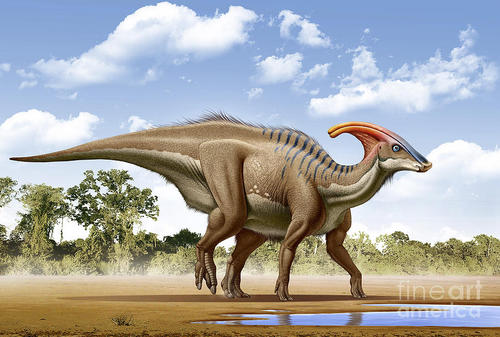One of the crested hadrosaurs, this dinosaur has been the subject of controversy for quite some time.
Meaning of name: Almost/Near Crested Lizard
Species: Parasaurolophus walkeri, Parasaurolophus cyrtocristatus and Parasaurolophus tibicen.
Classification: Ornithopoda, Iguanodontia, Hadrosauroidea, Lambeosaurinae, Parasaurolophini.
Size: 9.5-10 meters (31-33 feet).
Weight: 2.5 metric tonnes (2.46 imperial tons).
Time: Campainian to Maastrichtian stages of the Late Cretaceous.
Location: Specimens have been found ranging from New Mexico, USA, to Alberta, Canada).
Named by: William Arthur Parks, in 1922.
Parasaurolophus is one of the more well known weird-looking dinosaurs. To me they always appeared normal, but the large crest atop the skull is always the centre of attention when it comes to the general public… and is still quite the topic of discussion among palaeontologists.
Species of Parasaurolophus are differentiated by the curve of the crest, sexes are differentiated by the size of the crest in relation to the rest of the body. It was once thought that the crest was used for nasal breathing, but the amount of passages and openings within the structure of the crest would have made breathing through it incredibly difficult. It is more commonly thought that the crest would have been used as a resonator and amplifier, allowing for communication over long distances; this makes more sense, as blowing air through casts of the crest has produced a cacophony of sounds, one would imagine Parasaurs as having all manner of nasal flaps within the tubes of the crest to control the pitch and volume of the calls being made.
It is also possible that the crest gave the Parasaurolophus a highly acute sense of smell, but this is only a possibility and has yet to be backed up by any credible evidence.
Parasaurolophus was most definitely not a solitary animal, living and moving in small herds of up to five or six individuals; effectively becoming part of a much larger herd, as each smaller herd was in constant communication with all the other herds in the nearby areas.
The duck-like mouth and wide-splaying feet often give people the impression that this creature was at least semi-aquatic. While the possibility is certainly hard to deny, the wide feet are most definitely suited to life in a bog or swamp-like environment (wide feet makes it harder to sink into soft ground).
There has always been question of how Parasaurolophus (and many other hadrosaurs) moved around. Did they walk on all fours or on two legs? The most commonly accepted theory is that they walked around on two legs and occasionally went down on all fours, especially when browsing for food on the ground.
This has been Parasaurolophus, this has been me, and you’ve been reading Dinosaurs Made Easy.
Sidenote: Hey all, I apologise for not posting lately, I haven’t been paying enough attention to my blog lately but that is all about to change.
Image courtesy of: A Dinosaur A Day (Tumblr).
